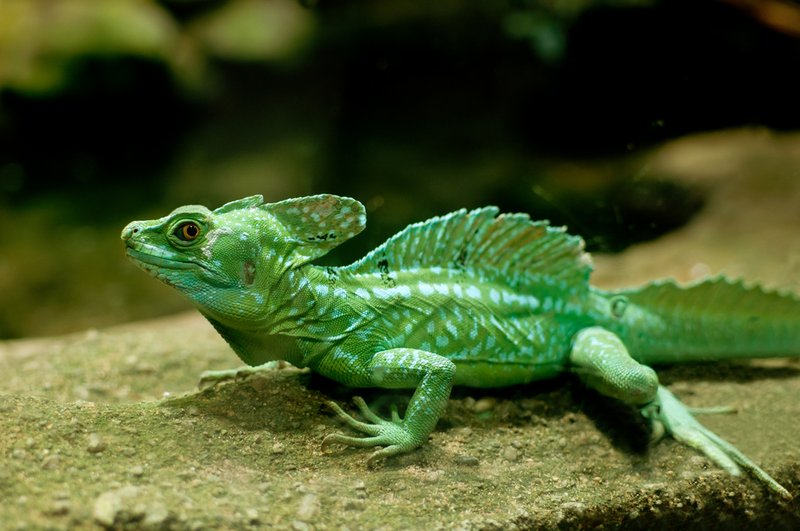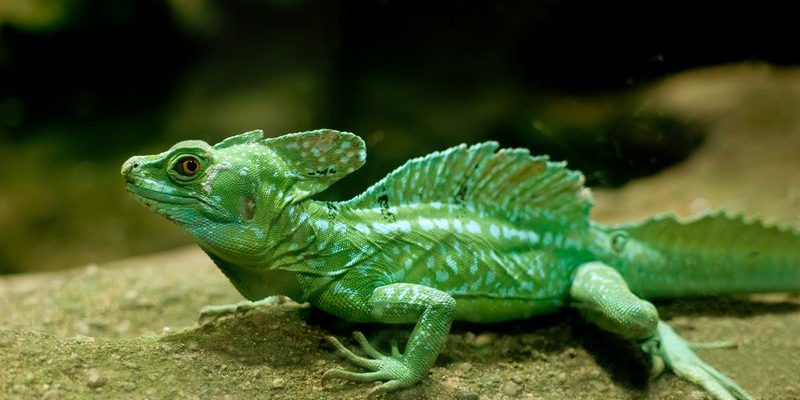
If you’re interested in wildlife or just curious about these unique lizards, knowing how to identify them is essential. Whether you’re hiking through the humid jungles of Central America or exploring local gardens, recognizing the basilisk lizard can enhance your outdoor adventures. So grab your binoculars, and let’s dive into what makes these lizards so special!
Physical Characteristics of Basilisk Lizards
To identify a basilisk lizard, you need to understand its distinctive features. One of the most striking characteristics is its color. Most species of basilisk lizards are a vibrant green, but they can also appear in shades of brown, depending on their environment. This helps them blend in with the lush foliage, a clever survival tactic. Imagine trying to spot your friend in a crowd based on their bright shirt—it’s similar with basilisk lizards and their vibrant hues.
Their body shape is another telling sign. Basilisk lizards have long, slender bodies and elongated tails that can be nearly twice the length of their bodies. This helps them balance when they sprint over water or climb up trees. Think about how a tightrope walker needs to keep their balance; these lizards do the same but in a more thrilling way!
Additionally, watch for their unique frills and crests, particularly on the males. These can be seen along their backs and necks, and during mating season, they puff them out to attract females. It’s like putting on a flashy outfit to get noticed at a party!
Behavior and Movement
Basilisk lizards are known for their remarkable agility. When you see one, you’ll often notice how quickly it can scurry away. They can sprint on their hind legs, often propelling themselves across water with a series of rapid movements. Picture a runner starting a sprint; that’s the kind of energy these lizards exude!
Watch how they interact with their surroundings. Basilisks are typically found near water sources, as they need it for their survival. If you’re near a stream, pond, or river, keep your eyes peeled. You might observe them basking on rocks or darting into the water to escape predators. It can be fascinating to see how they utilize their environment for both hunting and evasion.
Another behavior to note is their dewlap display. Male basilisk lizards often extend a flap of skin under their jaws to assert dominance or attract mates. If you see one doing this, it’s like watching a peacock displaying its feathers—essentially a vibrant showcase of courtship and territory.
Habitat Preferences
Basilisk lizards thrive in specific habitats that provide the right conditions for their survival. They are primarily found in Central and South America, often in tropical rainforests and near flowing water. You might expect to find them lounging on the banks of rivers or climbing trees near bodies of water. Think of them as the ultimate water-loving adventurers!
These lizards enjoy warm, humid environments, which makes them less commonly seen in cooler climates. If you’re searching for them, focus your efforts in dense foliage where they can easily camouflage. Spotting them can be tricky, so patience is key. It’s like playing hide and seek in nature!
Another interesting aspect is how they adapt to their habitat. Basilisk lizards are excellent climbers. They can often be found perched on branches, soaking up the sun or watching for potential food. If you’re exploring areas with a mix of water and trees, you might just find one basking in the sunshine.
Identifying Different Basilisk Species
There are several species of basilisk lizards, each with its unique characteristics. The most common are the Green Basilisk (Basiliscus plumifrons) and the Common Basilisk (Basiliscus basiliscus). Knowing the differences can help you pinpoint which one you’re observing.
The Green Basilisk is usually bright green with a crest along its back and is known for its agility. In contrast, the Common Basilisk is more variable in color, showing shades of brown and green. Both species can showcase the incredible water-running ability that makes them famous.
When you’re out in the wild, look closely at their markings. Some species might have spots or stripes, while others are more solid in color. It’s like comparing different varieties of apples—some are shiny and red, while others are more muted and speckled.
In addition to color and markings, size can be a telling indicator. Generally, the Green Basilisk can reach up to 3 feet in length, including the tail. The Common Basilisk tends to be a bit shorter, making size another distinguishing factor to consider.
Listening for Sounds
While most of us might think of lizards as quiet creatures, basilisk lizards can be quite vocal, especially during mating seasons. They have a variety of sounds, from hisses to chirps, that can help indicate their presence. If you’re out in the wild and hear a series of rapid clicks or hisses, pay attention—it could be a basilisk trying to communicate!
Listening for these sounds can be an enjoyable way to identify them, especially in dense jungles where visibility may be limited. It’s like trying to find a musician in a crowded concert; the sounds are your best guide!
Don’t forget that these sounds can vary between species. The calls of the Green Basilisk might be different from those of the Common Basilisk. So, when you hear a lizard making noise, think of it as an auditory clue leading you closer to your target!
Tips for Spotting Basilisk Lizards
If you’re planning a trip to find basilisk lizards, a few tips can help improve your chances. First, look for them in the early morning or late afternoon. These are the best times for observing reptiles since they’re most active when temperatures are moderate. Think of it as their version of “happy hour”—a perfect time to catch some sun and search for food!
Second, be patient and move slowly. Sudden movements can scare them away. Imagine trying to sneak up on a deer; it’s all about being quiet and calm. If you’re in the right habitat, you might find a basilisk basking in the sun or darting across the water.
Finally, bring along a pair of binoculars. These will help you see them from a distance without disturbing their natural behaviors. It’s like having a backstage pass to nature!
Spotting a basilisk lizard in the wild can be a thrilling experience, especially when you know what to look for. From their vibrant colors and unique behaviors to their fascinating habitats, these lizards are truly remarkable creatures. By understanding their physical characteristics, behaviors, and sounds, you’re more likely to enjoy this incredible encounter.
Next time you venture into the wild, keep these tips in mind. With a little patience and a keen eye, you might just catch a glimpse of one of nature’s most extraordinary lizards. Happy lizard hunting!

